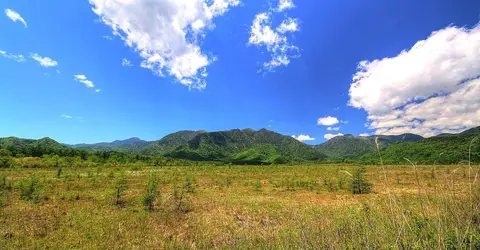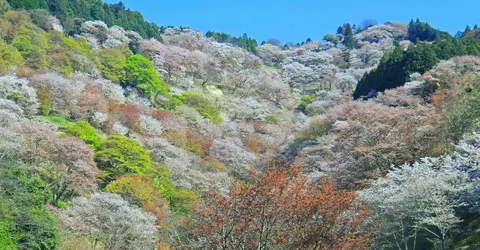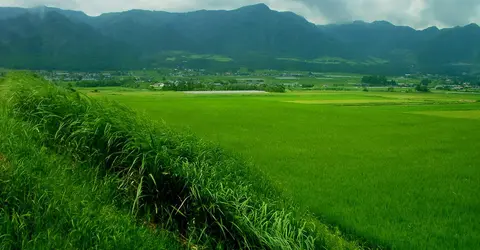10 of the best national parks in Japan 国立公園ランキング
National Parks of Japan
In Japan, national parks have been classified by the Ministry of the Environment since 1934. They are governed by law with the aim of protecting nature and the landscape for future generations to enjoy.
On some parks, private land, forestry industries and the people who live there remain. It is therefore a cooperation between the wishes of the government in accordance with the daily life of these people. For example, more than 90% of the surface of Ise-shima National Park is private, while the average is usually 25% for all national parks (60% owned by the state).
Today there are 34 national parks in Japan. We have selected ten of the most interesting or symbolic.
Hokkaido: Shiretoko National Park

Shiretoko National Park
wikimedia Commons
Shiretoko means "at the end of the earth" in the Ainu language, to understand where you are. The landscapes are magnificent; the feeling of space and freedom is total. Wild animals can be seen through the seasons, especially at the edge of the five mysterious lakes at the foot of Mount Shiretoko. Each winter, the arrival of the ryuhyo (drift ice from Siberia) to Rausu is a precious event, while in summer, you can see dolphins. This park is also a UNESCO World Heritage Site.
See also: Drift ice in Abashiri
Tohoku: Sanriku Fukko National Park (southern prefectures of Aomori, Iwate and the Oshika peninsula)

Sanriku Fukko National Park
wikimedia Commons
This park is spread over 600 kilometers of the Pacific coast of Sanriku, which was severely damaged by the Tsunami of March 2011. From this, the word "fukko" refers to restoring this bruised nature to the best conditions for the next generation and teaching them the threats of nature.
Tohoku: Bandai Asahi National Park (Yamagata, Fukushima and Niigata prefectures)

Bandai Asahi National Park
Wikimedia Commons
In this park, nature and tradition blend, the 3 Dewa mountains have been the sites of shugendo (Japanese spiritual tradition) for 1,400 years and therefore attract pilgrims from all over Japan. Created by nature, the Bandai Mountains as well as Lake Inawashiro are calming landscapes to enjoy.
Kanto: Nikko National Park (Fukushima, Tochigi and Gunma prefectures)

The Senjogahara marshland in the Nikko National Park
Wikimedia Commons
A volcanic region, the Shirane and Nantai mountains are still active and sometimes inaccessible to the public. Apart from that, the landscapes are fabulous, made of lakes, waterfalls and wetlands. In addition to these particular landscapes, cultural heritages like Toshogu and Futarasan make it possible to combine culture and history in the heart of nature. Access is quick and easy from Tokyo. UNESCO classified site.
Read the full article: Nikko
Kanto: Fuji-Hakone-Izu National Park (Kanagawa, Shizuoka, Tokyo and Yamanashi prefectures)

Fuji-Hakone-Izu National Park
Wikimedia Commons
Fujiyama is the sacred mountain and a symbol of Japan all over the world. With its lakes all around, beautifully reflecting its silhouette, there are many places of contemplation. Hakone, on the Tokaido road, is a great place to take advantage of the onsen (thermal springs). In Izu, in addition to the onsen, marine sports are offered in the middle of the small islands.
Chubu: Chubu Sangaku National Park (Toyama, Nagano and Gifu prefectures)

Chubu Sangaku National Park
wikimedia Commons
Located in the heart of the Japanese Alps, the mountains are omnipresent, with peaks over 3,000 meters and deep valleys. Glaciers remain all year round and alpine plants grow everywhere on the slopes. With luck you will be able to see the raicho the bird also called "rock ptarmigan", symbol of the region.
To read: The Japanese Alps
Kinki: Yoshino-Kumano National Park (Mie, Nara and Wakayama prefectures)

Yoshino-Kumano National Park
Wikimedia Commons
Famous for the incredible flowering of its 30,000 cherry trees in spring, this park is home to Mount Yoshino, where the cherry tree is sacred. One of the pilgrimage routes to Kumano Kodo is located here, from Yoshino to Kumano, 80 kilometers long and two important places of religion.
Chugoku: Daisen Oki National Park (Tottori, Shimane and Okayama prefectures)

Daisen Oki National Park
wikimedia Commons
In Japanese mythology, there are two sacred mountains which are Mount Daisen, the symbol of Tottori, and Mount Sanbe, located in Shimane. The coast of the Nihon Kai (the Sea of Japan) here is remarkable, where natural erosion has sculpted the rock into magnificent cliffs. On the cultural side, it is the Izumo Taisha temple that attracts visitors.
For more details: Daisen Oki National Park
Kyushu: Aso-Kuju National Park (Kumamoto and Oita prefectures)

Aso Kuju National Park
jerome Laborde
In Kyushu's center, the immense caldera welcomes you with its green meadows and the bubbling Aso volcano. The Kuju mountains form a string of ten very active volcanoes, dynamic nature that is still evolving. Perfect for feeling the volcanic activity, as well as for bathing in hot springs.
Kyushu: Yakushima National Park (Kagoshima Prefecture)

Yakushima National Park
Wikimedia Commons
In the south of Japan, about sixty kilometers from Kagoshima, this national park is made up of mountainous islands, part of which is Yakushima and Kuchinoerabujima. 90% of the surface is made up of forests, the magical scenery of ancient cedars and moss inspired Miyazaki's animated film, Princess Mononoke. You can meet the Jomon Sugi, which is said to be the oldest and largest cedar, with an estimated age of between 2,000 and 7,000 years! There is also a hiking trail of 22 kilometers. This is also a UNESCO classified site.
Read also: Yakushima













